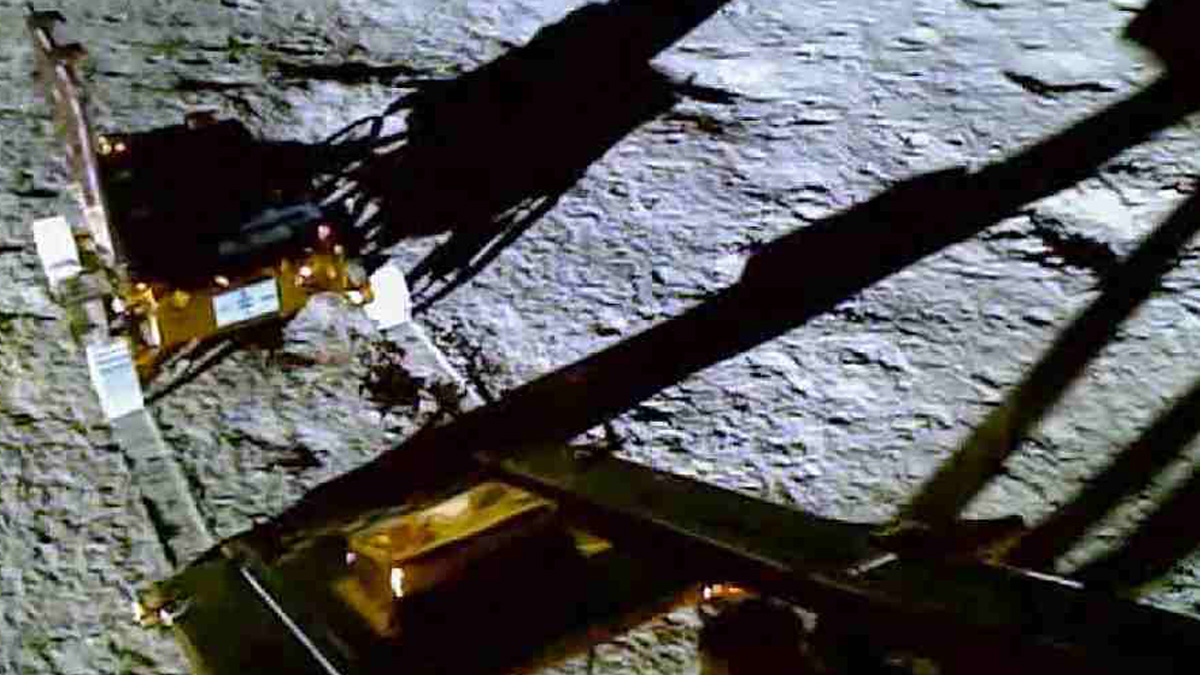
Pragyan rover traverses 8 metres on lunar surface, its payloads turned on

Chandrayaan-3 mission’s rover ‘Pragyan’ has traversed a distance of about eight metres on the lunar surface, and its payloads have been turned on, ISRO said on Friday.
All payloads on the propulsion module, lander module, and rover are performing nominally, the Bengaluru-headquartered national space agency said in an update this evening.
“All planned rover movements have been verified. The rover has successfully traversed a distance of about 8 metres. Rover payloads LIBS and APXS are turned ON,” it said in a post on ‘X” The Alpha Particle X-Ray Spectrometer (APXS) is aiming at deriving the chemical composition and infering the mineralogical composition of the lunar surface.
The Laser-Induced Breakdown Spectroscope (LIBS) is attempting to determine the elemental composition (Mg, Al, Si, K, Ca, Ti, Fe) of lunar soil and the rocks around the lunar landing site.
Earlier on Friday, ISRO released a breathtaking video of the the rover, ‘Pragyan’, rolling down the ramp from the lander, ‘Vikram’, to the lunar surface, as observed by the lander imager camera.
“… and here is how the Chandrayaan-3 Rover ramped (rolled) down from the lander to the lunar surface,” ISRO said in an update.
The space agency also released the image of ‘Vikram’ taken by Chandrayaan-2’s Orbiter High Resolution Camera (OHRC) after the lander module soft landed on the lunar surface.
“Chandrayaan-3 Mission update: I spy you! Chandrayaan-2 Orbiter photoshoots Chandrayaan-3 Lander! Chandrayaan-2’s Orbiter High-Resolution Camera (OHRC) — the camera with the best resolution anyone currently has around the Moon — spots Chandrayaan-3 Lander after the landing on 23/2³/23,” ISRO said in the post, using its well-received informal social media approach.
Chandrayaan-2 Orbiter, launched in 2019, continues to orbit the Moon.
The Vikram lander with Pragyan rover in its belly touched down on the Moon’s surface “well within the area” identified for the purpose on Wednesday.
A few hours after the landing, the 26-kg six-wheeled rover rolled out from the lander’s belly.
ISRO said on Thursday evening: “All activities are on schedule. All systems are normal. Lander Module payloads ILSA, RAMBHA and ChaSTE are turned ON today. Rover mobility operations have commenced. SHAPE payload on the Propulsion Module was turned ON”.
ILSA is meant to measure seismic activity around the landing site, while RAMBHA will study the plasma environment around the Moon.
Chandra’s Surface Thermophysical Experiment (ChaSTE) will measure surface thermal properties of the Moon.
India on Wednesday scripted history as its third unmanned Moon mission’s Lander Module made a flawless soft-landing, making it only the fourth country to achieve this feat, and first to reach the uncharted south pole of Earth’s only natural satellite.
- Kaski Court Grants Bail to Rabi Lamichhane in Embezzlement Case
- Upper Mustang Sees Over 4,000 Foreign Tourists in 2024, Marking a 14% Rise
- Hollywood Wildfires Ravage Los Angeles, Claiming Lives and Thousands of Homes
- Nepal Deports 147 Chinese Nationals in 2024 Amid Rising Concerns Over Crimes and Overstays












Comments